| |
A SONG THAT SAVED A TRAIN
Can you remember the haunting tune to this railroad song from the 1970s?
| |
|
|
| |
Good morning American how are you?
Don't you know me I'm your native son?
I'm the train they call The City of New Orleans,
I'll be gone five hundred miles when the day is done.
Dealin' card games with the old men in the club car
Penny a point ain't no one keepin' score
Pass the paper bag that holds the bottle
Feel the wheels rumblin' 'neath the floor. |
|
Written by Steve Goodman while aboard the pre-Amtrak, "Illinois Central Monday morning train", he claimed that everything in the song actually happened on the ride. The songwriter learned that the train was scheduled to be de-commissioned when Amtrak took over operation of the country's passenger trains. Hoping his song could save the train, he released it on his first album in 1971. The song became a smash hit when Arlo Guthrie later recorded it. Just after Goodman, the composer, passed away, it was awarded a Grammy as the Best Country Song of 1984.
While Amtrak, underfunded from the start, did need to cut a number of trains out of the system, The City of New Orleans is still in Amtrak's timetable 40 years on.
But what, you may ask, does this have to do with the Rio Grande Scenic Railroad in Colorado?
On May 27, 2011, vintage club cars mentioned in the song were officially dedicated in Alamosa, Colorado by the Rio Grande Scenic RR. Painted in the original brown and orange colors of the Illinois Central, the train's pre-Amtrak host, they will be carrying passengers this year between Alamosa and La Veta, powered by a steam engine. |
|
| |
|
|
| |
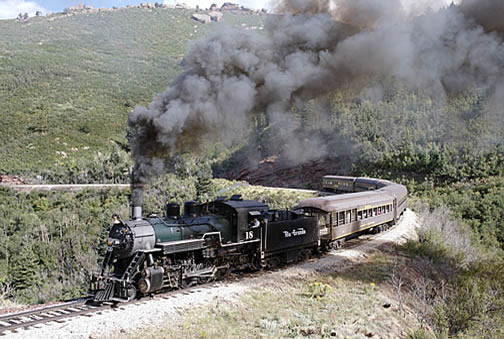 |
|
| |
Engine #18 and the Calumet Club Car |
|
| |
|
|
| |
Both restored club cars once ran on the City of New Orleans between the train's namesake and Chicago.
THE CALUMET CLUB CAR was built as a coach in 1918 by Pullman for the Illinois Central Railway. After Amtrak took over passenger trains in 1971, the car ended up on the Wisconsin and Calumet Railroad, and then went on the Orlando and Mt. Dora RR in Florida. After going into storage there, it moved to Arizona for the Copper Spike Excursion in 2008.
MARDI GRAS is the Calumet Club's sister. Built by Pullman in 1918 as a coach it was converted in 1947 to a round end observation lounge car. Both cars, as a possible inspiration for new livery for the entire RGSRR consist, are painted in the old IC colors, orange and brown with gold trim.
Amtrak took over most of the passenger train network in 1971, and later furnished The City of New Orleans with double-level Superliner equipment. This made the historic club cars redundant, so they were sold and used on various tourist railroads.
The Rio Grande Scenic Railroad offers a Club Car Package with nostalgic overtones. It includes a deck of Rio Grande playing cards, a sleeve of pennies, a CD, and a paper bag. While the paper bag doesn't "hold the bottle", it comes close -- with drink tickets inside. Passengers will also enjoy breakfast and lunch as they ride with the professional musicians who will give a concert when the train arrives at Fir.
The Rio Grande Scenic Railroad began operation in 2006 when a diesel pulled passengers through the remote San Luis Valley and the Spanish Peaks region.
Soon a vintage 1901 steam engine, former Southern Pacific Engine 1744, was added.
By the time we rode the train out of Alamosa in 2008, there were more steam engines on the property. The railroad had "modernized" by adding two former Lake Superior and Ishpeming locomotives built in 1910. One, LS&I -18, would pull our train. |
|
| |
|
|
| |
 |
|
| |
Train climbs into the mountains |
|
| |
|
|
| |
The other, LS&I-20, sat on display.
Number 18 wheezed to life with a showy blast of steam and chuffed towards the platform. We boarded a full-length dome (the company now owns nine) which had once carried cruise passengers through the scenic wonders of Alaska.
The San Luis Valley, where we were headed, was home to Spanish settlers by the 1850s. Alamosa was created shortly after the Denver and Rio Grande Western Railroad completed the narrow-gauge line here in 1878. A trainload of buildings was moved from Garland City to the wilderness that became Alamosa in one day. Alamosa became home to extensive maintenance and repair facilities. Eventually, the railroad branched out in four directions from Alamosa. By 1890, it was the hub of narrow gauge railroading in the west. Trains arrived and departed daily, carrying ore, lumber, livestock, and agricultural and farm products. Passenger trains linked Alamosa to Denver, Durango, Santa Fe, Salida, and Creede.
Once on board, we crossed over the Rio Grande River as we left town. The tracks led through ranchland and blooming sagebrush. The engineer proved he was a virtuoso on the steam whistle. The white, 700-foot high drifts of Sand Dunes National Park were visible to the north. Ahead, the lofty Sangre de Christo Mountains receded in both directions towards the horizon. |
|
| |
|
|
| |
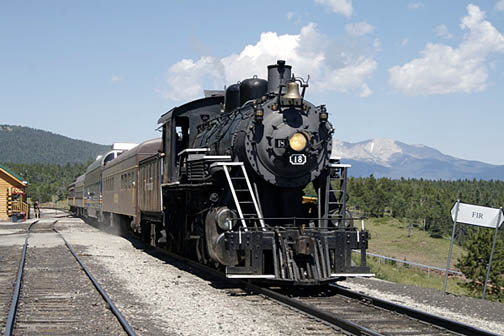 |
|
| |
Steam engine # 18 near Fir |
|
| |
|
|
| |
Suddenly we were in the kind of landscape that refreshes the soul; foothills surrounded by juniper trees, and about thirty elk, drinking from a nearby river. Climbing higher, the train was surrounded by pines, aspens and mountain meadows with weird rock formations. Away from roads here, there are few buildings in sight. |
|
| |
|
|
| |
|
|
| |
Heavy standard gauge tracks are still in use on the "Scenic Line of the World" |
|
| |
|
|
| |
We were beginning the long climb over La Veta Pass at 9,393 feet. When it was constructed in the late 1870s this crossing of the mountains was 1,000 feet higher than any other railroad in the US, and was hailed as an engineering marvel. The stunning scenery earned the railroad its slogan as the "Scenic Line of the World". |
|
| |
|
|
| |
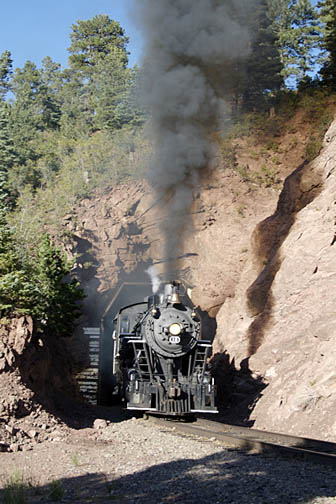 |
|
| |
Engine #18 blasts out of a tunnel |
|
| |
|
|
| |
Grades on the original line were steep with sharp turns. At Mule Shoe Curve, trains climbed a 4% grade while negotiating a 30 degree curve. By the early 1900s, an alternate route over gentler terrain suitable for standard gauge rails was constructed. This led to the abandonment of the precipitous narrow gauge route. Today, a ghost railroad bed across the valley clutches the side of cliffs still showing rock fills and cuts. More than a century later, the standard rails still are in use under the wheels of our train. |
|
| |
|
|
| |
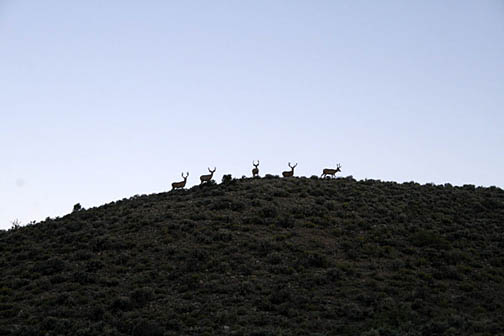 |
|
| |
Elk in silouette look down at train |
|
| |
|
|
| |
We stopped at 9240 feet, at a verdant meadow called Fir. Fresh-air concerts are performed for passengers here on some summer weekends. The stage and sound equipment are powered by a 60-foot wind turbine and a 5,000-watt solar system. |
|
| |
|
|
| |
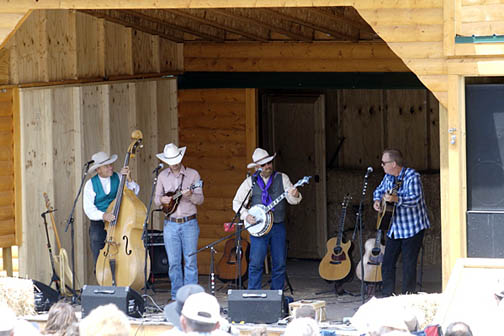 |
|
| |
Singers perform for passengers at Fir |
|
| |
|
|
| |
Carlos Llamas is a qualified conductor, fireman and steam-train engineer who began work on the Cumbres and Toltec Scenic Railroad (a nearby tourist operation that runs between Chama and Osier) around 1989. He is qualified to work on this railroad too, and had some stories to tell.
"Five-foot rattlesnakes like to cozy up to the rails at night to keep warm," he said. He has seen mountain lions, elk, and black bears along the tracks. |
|
| |
|
|
| |
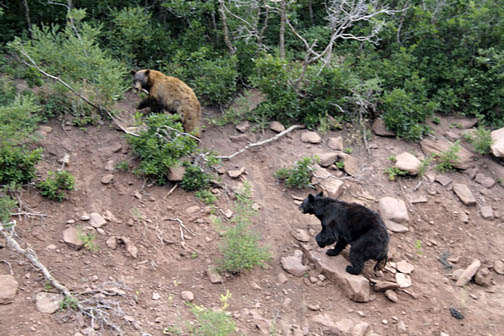 |
|
| |
Two bears seen from on board |
|
| |
|
|
| |
"What is it like to work in the cab of a steam engine?" we wondered.
"Temperatures can get up to 100 degrees inside," he said. "I've seen guys pass out from the heat. I carry Tylenol, Imodium chewing gum, and jerky (to replace salt in the body). Being dehydrated makes you feel sore and beat up and you can't sleep good -- kind of like a hangover. You need to drink lots of water, and keep eating oranges and gummy bears.
"You can get sleepy in the cab. What I do to stay alert is to put a handful of sunflower seeds in my mouth. Then I concentrate as I spit them out one at a time." He claimed that it cost about $2,000 in fuel for the steam engine to make the round trip from Alamosa to La Veta.
These days, the train is using recycled motor oil. According to Ed Ellis, President of Iowa Pacific (the holding company for this and several other tourist railroads), "We get it from Canon City from a company that collects it from oil-change shops. We not only get more BTUs now, but our costs have gone from $3.00 a gallon down to $1.60 per gallon."
Phil Beachler, the railroad's web developer, had this to say about fuel: "It takes about 1,100 gallons per round trip.......by comparison, diesel locomotives burn about 300 for the same trip." Sadly, that's one of several reasons why steam engines are a vanishing breed.
However, when you are riding in the open air sightseeing car behind the locomotive climbing La Veta Pass, the chugging and chuffing from Engine #18 is worth the price of admission. |
|
| |
|
|
| |
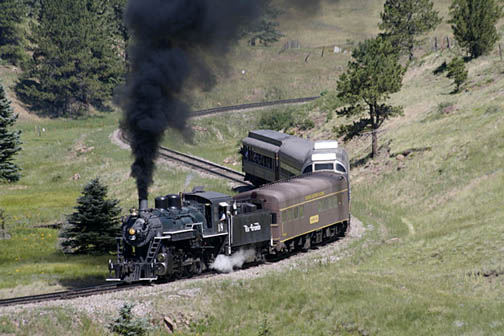 |
|
| |
Away from the highway, there are no other signs of civilization in sight |
|
| |
|
|
| |
The Railroad's 2011 season runs from May 27th to October 8th. The steam train operates out of Alamosa; diesel power pulls trains out of La Veta. There are Club Car Packages, dinner trains, steam specials and concert trains to choose from.
You may reach the DRGRR at 1-877-726-7245, or visit www.riograndescenicrailroad.com |
|
| |
|
|
|
|
|


